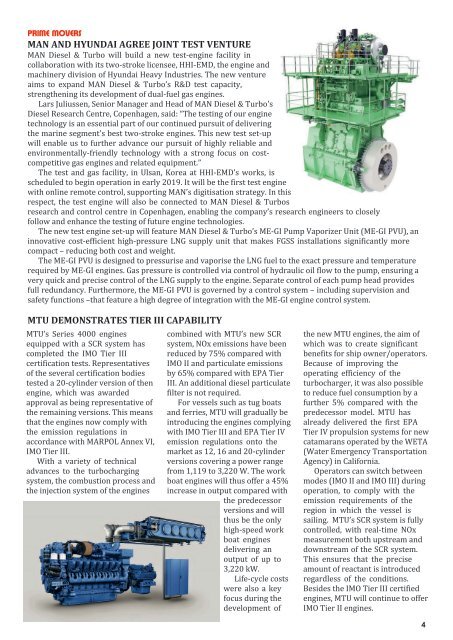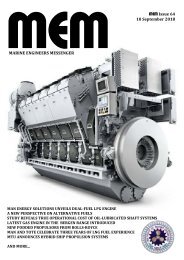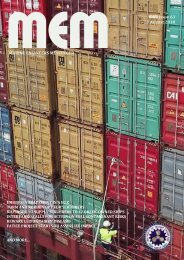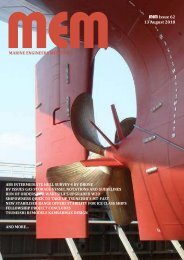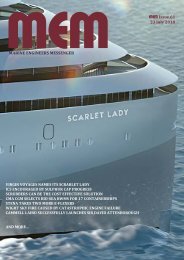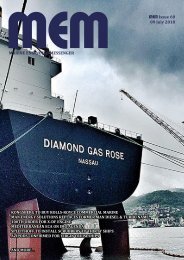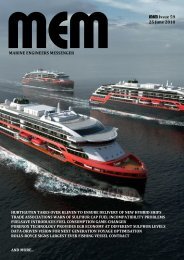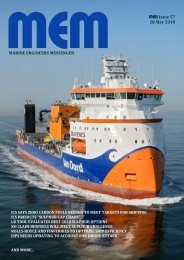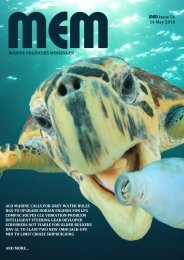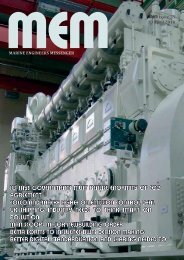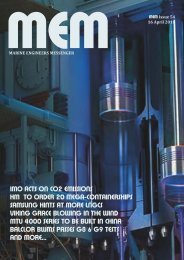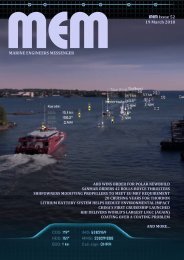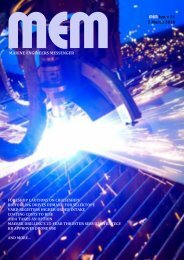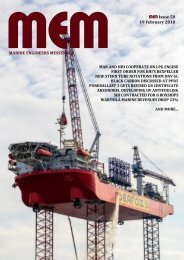Create successful ePaper yourself
Turn your PDF publications into a flip-book with our unique Google optimized e-Paper software.
PRIME MOVERS<br />
MAN AND HYUNDAI AGREE JOINT TEST VENTURE<br />
MAN Diesel & Turbo will build a new test-engine facility in<br />
collaboration with its two-stroke licensee, HHI-EMD, the engine and<br />
machinery division of Hyundai Heavy Industries. The new venture<br />
aims to expand MAN Diesel & Turbo’s R&D test capacity,<br />
strengthening its development of dual-fuel gas engines.<br />
Lars Juliussen, Senior Manager and Head of MAN Diesel & Turbo's<br />
Diesel Research Centre, Copenhagen, said: “The testing of our engine<br />
technology is an essential part of our continued pursuit of delivering<br />
the marine segment's best two-stroke engines. This new test set-up<br />
will enable us to further advance our pursuit of highly reliable and<br />
environmentally-friendly technology with a strong focus on costcompetitive<br />
gas engines and related equipment.”<br />
The test and gas facility, in Ulsan, Korea at HHI-EMD’s works, is<br />
scheduled to begin operation in early 2019. It will be the first test engine<br />
with online remote control, supporting MAN’s digitisation strategy. In this<br />
respect, the test engine will also be connected to MAN Diesel & Turbos<br />
research and control centre in Copenhagen, enabling the company’s research engineers to closely<br />
follow and enhance the testing of future engine technologies.<br />
The new test engine set-up will feature MAN Diesel & Turbo’s ME-GI Pump Vaporizer Unit (ME-GI PVU), an<br />
innovative cost-efficient high-pressure LNG supply unit that makes FGSS installations significantly more<br />
compact – reducing both cost and weight.<br />
The ME-GI PVU is designed to pressurise and vaporise the LNG fuel to the exact pressure and temperature<br />
required by ME-GI engines. Gas pressure is controlled via control of hydraulic oil flow to the pump, ensuring a<br />
very quick and precise control of the LNG supply to the engine. Separate control of each pump head provides<br />
full redundancy. Furthermore, the ME-GI PVU is governed by a control system – including supervision and<br />
safety functions –that feature a high degree of integration with the ME-GI engine control system.<br />
MTU DEMONSTRATES TIER III CAPABILITY<br />
MTU’s Series 4000 engines<br />
equipped with a SCR system has<br />
completed the IMO Tier III<br />
certification tests. Representatives<br />
of the several certification bodies<br />
tested a 20-cylinder version of then<br />
engine, which was awarded<br />
approval as being representative of<br />
the remaining versions. This means<br />
that the engines now comply with<br />
the emission regulations in<br />
accordance with MARPOL Annex VI,<br />
IMO Tier III.<br />
With a variety of technical<br />
advances to the turbocharging<br />
system, the combustion process and<br />
the injection system of the engines<br />
combined with MTU’s new SCR<br />
system, NOx emissions have been<br />
reduced by 75% compared with<br />
IMO II and particulate emissions<br />
by 65% compared with EPA Tier<br />
III. An additional diesel particulate<br />
filter is not required.<br />
For vessels such as tug boats<br />
and ferries, MTU will gradually be<br />
introducing the engines complying<br />
with IMO Tier III and EPA Tier IV<br />
emission regulations onto the<br />
market as 12, 16 and 20-cylinder<br />
versions covering a power range<br />
from 1,119 to 3,220 W. The work<br />
boat engines will thus offer a 45%<br />
increase in output compared with<br />
the predecessor<br />
versions and will<br />
thus be the only<br />
high-speed work<br />
boat engines<br />
delivering an<br />
output of up to<br />
3,220 kW.<br />
Life-cycle costs<br />
were also a key<br />
focus during the<br />
development of<br />
the new MTU engines, the aim of<br />
which was to create significant<br />
benefits for ship owner/operators.<br />
Because of improving the<br />
operating efficiency of the<br />
turbocharger, it was also possible<br />
to reduce fuel consumption by a<br />
further 5% compared with the<br />
predecessor model. MTU has<br />
already delivered the first EPA<br />
Tier IV propulsion systems for new<br />
catamarans operated by the WETA<br />
(Water Emergency Transportation<br />
Agency) in California.<br />
Operators can switch between<br />
modes (IMO II and IMO III) during<br />
operation, to comply with the<br />
emission requirements of the<br />
region in which the vessel is<br />
sailing. MTU’s SCR system is fully<br />
controlled, with real-time NOx<br />
measurement both upstream and<br />
downstream of the SCR system.<br />
This ensures that the precise<br />
amount of reactant is introduced<br />
regardless of the conditions.<br />
Besides the IMO Tier III certified<br />
engines, MTU will continue to offer<br />
IMO Tier II engines.<br />
4


